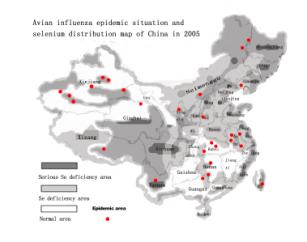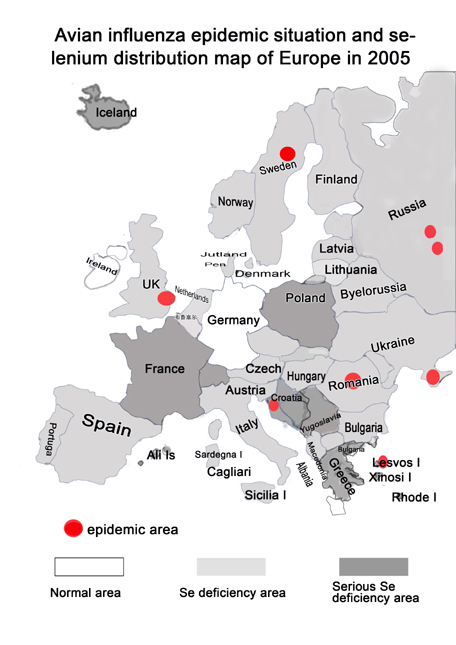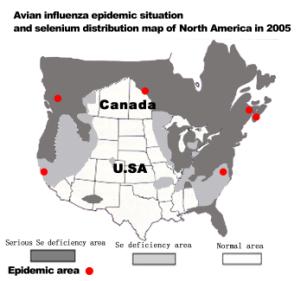
Figure 1: Avian influenza epidemic situation and selenium distribution map in China
Ass seen from the history of avian influenza, it broke out in Italy, a selenium deficiency country in Europe, followed by Spain, Russia and Holland, which are also lacking selenium. The earliest, largest and most widespread five incidences of avian influenza all broke out in selenium deficiency areas, and the areas where we see avian influenza in 2005 are also short of selenium (See Fig 2).

Figure 2: Avian influenza and selenium distribution in Europe
The United States of America and Canada have also conducted surveys on the selenium contents of their soil, and it can be seen from the North America selenium distribution map that the epidemic situation of avian influenza in 2005 also corresponds to the areas of selenium deficiency (see Fig.3). As reported, Southeast Asia is also recognized as a selenium deficiency area. However, its selenium distribution map can not be drawn here because detailed selenium composition surveys are not available.

Figure 3: North America - avian influenza and selenium distribution
It happens that there was a similar case of large scale occurrence of disease caused to humans by lack of selenium. This was keshan disease, an endemic disease caused by the lack of selenium in the early days of the foundation of our country. Its was manifested as cough, oppressed feeling in chest, difficult breathing, generalized hydrops (edema), pulmonary edema, heart failure and finally led to death. Researchers found Coxsackie’s virus in the heart of the dead, and the question was, why had this normally benign virus turned malign? Further research showed that it was because of selenium deficiency.
Premier (Zhou EnLai) made a prompt decision to supplement selenium for 9,000,000 people in 310 areas of over 10 provinces, and the disease was controlled. This was a miracle of worldwide import. When avian influenza viruses attack once again, we should pay attention to the macroscopic relation between the disease and selenium deficiency.
2. The relation between selenium and avian influenza viruses as seen from a microscopic view
As seen from a microscopic view, avian influenza virus is bacilliform or spherical in shape. The spherical virus has a diameter of 80-120nm and is covered by cyst membranes. The hemagglutinin of the outer cyst membrane is labeled with “H”, and according to different protein antigens, is marked with “H1-H5”, while its neuramidinase is labeled with “N”, or “NB1-N9”. The combination H5N1 denotes a highly pathogenic virus. What is the relationship between virus and selenium? It can be described directly and indirectly.
2.1 Direct relation between selenium and virus
The delicate relation between selenium and virus is determined by the characteristics of selenium. Selenium is either a beneficial element essential to the reproduction of living beings or a harmful element with toxicity, and the threshold between the two is very narrow.